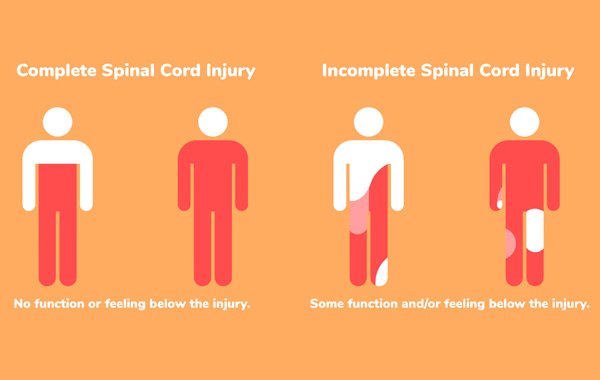Spinal cord injury are life-altering and can vary in severity. From complete loss of motor and sensory function to partial impairment, each level of injury presents unique challenges to patients. We will explore how these injuries affect mobility, strength, and bodily functions.
By understanding the different levels of SCI, you will gain a clearer picture of the physical and emotional journey faced by those affected. Nevertheless, with this knowledge, you can better support yourself, a loved one, or your patients in coping with the challenges and adjustments that come with a spinal cord injury.
Types and Classifications of SCI
Spinal cord injuries can be classified into two main categories: complete and incomplete. A complete SCI refers to the loss of all motor and sensory function below the level of injury. On the other hand, an incomplete SCI means that there is some degree of motor or sensory function below the level of injury.
Within these categories, there are different levels of spinal cord injury based on where the injury occurs along the spinal cord. The spinal cord is divided into four regions: cervical, thoracic, lumbar, and sacral. Each region controls different parts of the body, and an injury at a specific level can result in varying degrees of impairment.
Understanding the Levels of Spinal Cord Injury
Cervical Spinal Cord Injury
Cervical spinal cord injuries occur in the neck region and can have serious consequences. Higher-level injuries in the cervical region can result in quadriplegia, where all four limbs and the trunk are affected which leads to a loss of function in the arms, hands, and legs, making daily activities challenging. This can impact mobility, balance, and coordination.
Thoracic/Dorsal Spinal Cord Injury
Thoracic spinal cord injuries occur in the upper back region and can lead to high-level paraplegia. The severity of impairment will depend on the specific level of injury. Individuals with thoracic spinal cord injuries may experience difficulty with trunk control, balance, and bowel and bladder function.
Lumbar Spinal Cord Injury
Lumbar spinal cord injuries occur in the lower back region and typically result in paraplegia. The extent of impairment will vary based on the level of injury. Furthermore, Individuals with lumbar spinal cord injuries may face challenges with walking, standing, lower limb function, and bowel and bladder control. In addition, earlier the trunk control is also impacted but with the proper rehabilitation it gets better .
Sacral Spinal Cord Injury
Sacral spinal cord injuries occur in the lowest region of the spine and can lead to varying degrees of impairment. These injuries can affect bowel, bladder, and sexual function, as well as lower limb strength and mobility. Unlike Cervical or Dorsal level, Sacral level doesn’t impact trunk control.
Complications and Long-term Effects of Spinal Cord Injury
Spinal cord injuries can have a range of complications and long-term effects. Some common complications include pressure sores, urinary tract infections, respiratory problems, muscle atrophy, and osteoporosis. Additionally, individuals with spinal cord injuries may also experience psychological effects, such as depression and anxiety.
Moreover, long-term effects can include chronic pain, spasticity, loss of muscle tone, and decreased cardiovascular health. It’s crucial for healthcare professionals to address these complications and provide appropriate interventions to enhance the quality of life for patients with spinal cord injuries.
Conclusion
Understanding the different levels of SCI is essential for healthcare professionals, patients, and individuals seeking knowledge about this topic. By gaining insights into the types, classifications, and levels of SCI, we can better comprehend the challenges faced by those affected. Moreover, being aware of the available treatment options and rehabilitation techniques allows for better support and care for individuals with spinal cord injuries. Let us empower ourselves with knowledge and empathy as we navigate the complexities of SCI.

